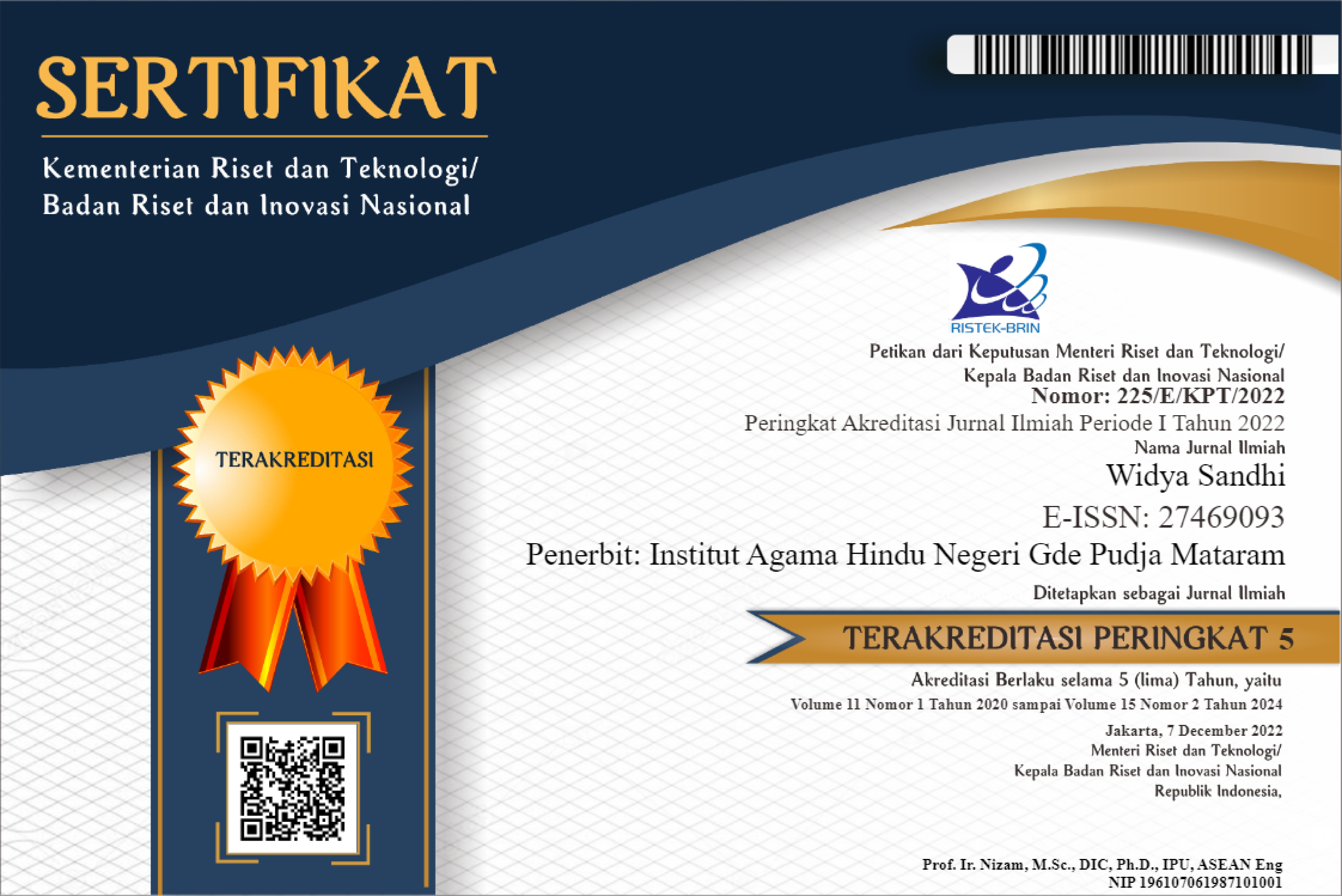ETIKA RELIGIUS DALAM TEKS LONTAR SILAKRAMANING AGURON-GURON: SEBUAH ANALISIS POLA INTERAKSI GURU-SISWA
Abstract
This study focuses on the study of religious ethics in the lontar text of Sila Kramaning Aguron-guron in building a pattern of interaction between teachers and students (sisya) according to Hindu teachings. The method used is an interpretive qualitative method using a content analysis pattern. This study focuses on the description of the teachings of religious ethics contained in the lontar Sila Kramaning Aguron-guron on sheet 1b and analyzes the aspects of the teachings related to building patterns of interaction between teachers and students (sisya). This study formulated three results in accordance with those formulated in the research focus. First, the description of the lontar is more focused on the aspect of religious ethics that must be adhered to and obeyed by the student (sisya) in improving spiritual quality in order to achieve the goal of life in accordance with what is taught in the teachings of Hinduism. Second, the essential values contained in the lontar Sila Kramaning Aguron-guron are related to building patterns of interaction between teachers and students in everyday life. In essence, the teachings taught in the lontar text must be used as guidelines by Hindus who want to improve the quality of spiritual life in achieving eternal freedom.
References
Chakrabarti, Kisor Kumar. (2001). Classical Indian Philosophy of Mind: The Nyāya Dualist Tradition. New Delhi: Motilal Banarsidas Publisher.
Grondin, Jean. (2007). Sejarah Hermeneutik: dari Plato sampai Gadamer. Terjemahan Inyiak Ridwan Muzir. Yogjakarta: Ar-Ruzz Media
Kadjeng, I Nyoman dkk. (2005). Sarasamuçcaya dengan Teks Bahasa Sanskerta dan Jawa-Kuno. Jakarta: Pustaka Mitra Jaya
Maswinara, I W. (2006). Sistem Filsafat Hindu (Sarva Dar śana Saṁgraha. Surabaya: Pāramita
Prarjato, Nunung. (2010). Psikologi Komunikasi:Faktor Psikis dalam Komunikasi Antarmanusia. Yogyakarta: Fisipol UGM
Pudja, G. (2003). Bhagavad Gītā: Pancamo Veda. Surabaya: Paramita.
Radhakrisnan, S. (1999): Indian Philosophy. Volume II. New Delhi: Oxford Universuty Press
Suamba (200)3. Dasar-Dasar Filsafat India. Denpasar: Program Magister Ilmu Agama dan Kebudayaan Universitas Hindu Indonesia Bekerjasama dengan Widya Dharma
Suhardana, K.M. (2016). Pengantar Etika dan Moralitas Hindu: Bahan Kajian untuk Memperbaiki Tingkah laku. Surabaya: Paramita
Sumaryono, E.(1999). Hermeneutik Sebuah Metode Filsafat. Yogyakarta:Kanisius.
Sura, I Gede. (2001).Pengendalian Diri dan Etika dalam Ajaran Agama Hindu. Jakarta: Hanuman Sakti
Sudarto. (1996). Metodologi Penelitian Filsafat. Jakarta: PT. RajaGrafindo Persada
Sumawa, I Wayan dan Krisnu, Tjokorda Raka.(1996). Materi Pokok Darsana: Modul 1-12. Jakarta: Direktorat jenderal Bimas Hindu dan Budha Departemen Agama republik Indonesia
Tim Penyusun.(2006). Buku pendidikan Agama Hindu untuk Perguruan Tinggi. Surabaya: Paramita
Triguna, I.B.G. (2000). Teori Tentang Simbol. Denpasar: Widya Dharma
...............(1994). “Pergeseran Dalam Pelaksanaan Agama: Menuju Tattwa” dalam Buku Dinamika masyarakat dan Kebudayaan Bali. Editor: I Gde Pitana. Denpasar : BP

This work is licensed under a Creative Commons Attribution-NonCommercial-ShareAlike 4.0 International License.
Authors who publish with this journal agree to the following terms:
- Authors retain copyright and grant the journal right of first publication with the work simultaneously licensed under a Creative Commons Attribution-ShareAlike 4.0 International License. that allows others to share the work with an acknowledgment of the work's authorship and initial publication in this journal.
- Authors are able to enter into separate, additional contractual arrangements for the non-exclusive distribution of the journal's published version of the work (e.g., post it to an institutional repository or publish it in a book), with an acknowledgment of its initial publication in this journal.
- Authors are permitted and encouraged to post their work online (e.g., in institutional repositories or on their website) prior to and during the submission process, as it can lead to productive exchanges, as well as earlier and greater citation of published work (See The Effect of Open Access).






.jpg)




